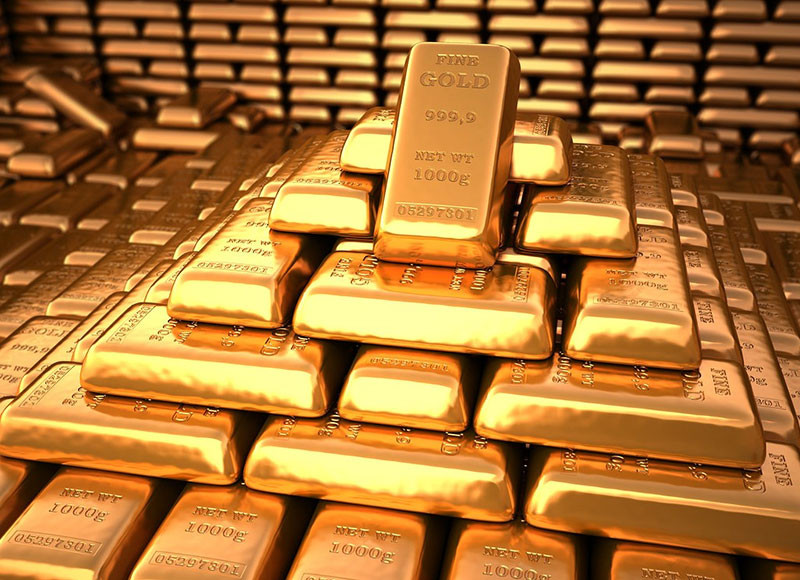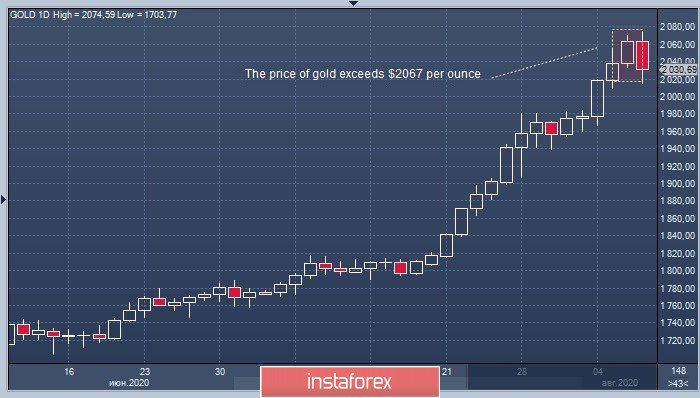
The confrontation between the yellow metal and the US currency is gaining momentum. According to analysts, it may worsen this week, giving a head start to the dollar, the recent strengthening of which was supported by positive reports on the US labor market (Non-farms). At the same time, gold holds the leading position against the US dollar, remaining the antagonist of the "American".
Experts fear that the leading precious metal, which sharply rose last week, could drop. Let us remind you that the historical date for gold was last Tuesday, August 4, when it exceeded the level of $ 2000. Two days later, on August 6, the price of gold soared to new highs and exceeded $ 2067 per 1 ounce. From that moment on, the precious metal remains at a high level, which is maintained by the political instability in the United States and the sinking of the dollar.

Among the political conflicts, which became a kind of lift for the price of gold, was the recent conflict between American leader Donald Trump and the US Democratic Party. It should be recalled that the head of the White House tried to agree with her on another program of financial assistance to Americans in order to neutralize the negative consequences of the COVID-19. However, this attempt was unsuccessful.
It should be noted that the previous financial aid program ended at the end of last month. According to preliminary estimates, 31.3 million American unemployed people need such support. The new amount of payments may increase threefold compared to the previous one. According to analysts, such a rush on the part of D. Trump regarding the adoption of a new financial aid program is due to the upcoming presidential elections. Thus, the American leader needs to implement his plan in order to "score points" in the US Congress in the near future. In case of delaying a positive decision on the financial aid program by the Congress, D. Trump loses points, while consumer sentiment in the country deteriorates and a serious imbalance arises in the market situation.
According to experts, there are a number of pitfalls in the adoption of the next financial aid package. If this scenario is implemented, the US budget deficit will sharply grow in the current financial year (up to $ 4 trillion, or about 20% of the country's GDP). It can be noted that the US national debt reached an impressive $ 26.5 trillion, or 136.6% of GDP. In the event of a sharp increase in the budget deficit, the US Federal Reserve is ready to come to help again, turning on the printing press. Experts say that a dollar rain of trillions of fiat money is capable of finally devaluing the dollar.
Against this background, the rise in the price of gold is natural. According to preliminary estimates, it amounted to 35% since the beginning of this year. The continued price rally of the precious metal indicates that the purchasing power of the USD is rapidly declining. As a result, the dollar is losing to gold on all fronts, losing its already shaken prestige.
However, despite the current optimism in the precious metals market, experts record alarming signs of a downward trend, which are emerging as small islands in the sea of "golden" positive. They are not striking, but they become noticeable upon close examination. Such signs include short-term and small drawdowns in the price of gold. By the beginning of this week, the precious metal, aimed at breaking the $ 2070 barrier, suddenly declined. On the morning of Monday, August 10, the price of gold fell to $ 2030 per ounce, although it rose slightly later. Gold has strengthened its position once again, but the first alarm bells raise concerns of experts.
One of the key drivers of the rise in the precious metal is still the high risk of devaluation of the US currency. According to experts, the USD has fallen by 99% against gold over the past 88 years. As a result, there is very little left before the critical drawdown of the dollar (up to 100%) in the XAU/USD pair, and then the last stronghold of the world economy called the US dollar will finally fall under the attack of gold.
In this respect, the current policy of the world central banks is indicative. Despite the progressive increase in the price of the key precious metal, regulators prefer to keep gold in their reserves, rather than sell it. Central banks seek to accumulate so-called "good money", that is, gold reserves, and try to get rid of "bad money", that is, fiat currencies. It should be noted that the dollar is one of these currencies that can depreciate.
The value of the yellow metal will rise in the near future, offsetting the decline in the purchasing power of fiat means of payment. According to analysts, the purchasing power of reliable assets, primarily gold, will not only not sink, but will also increase in the short and medium term.





















